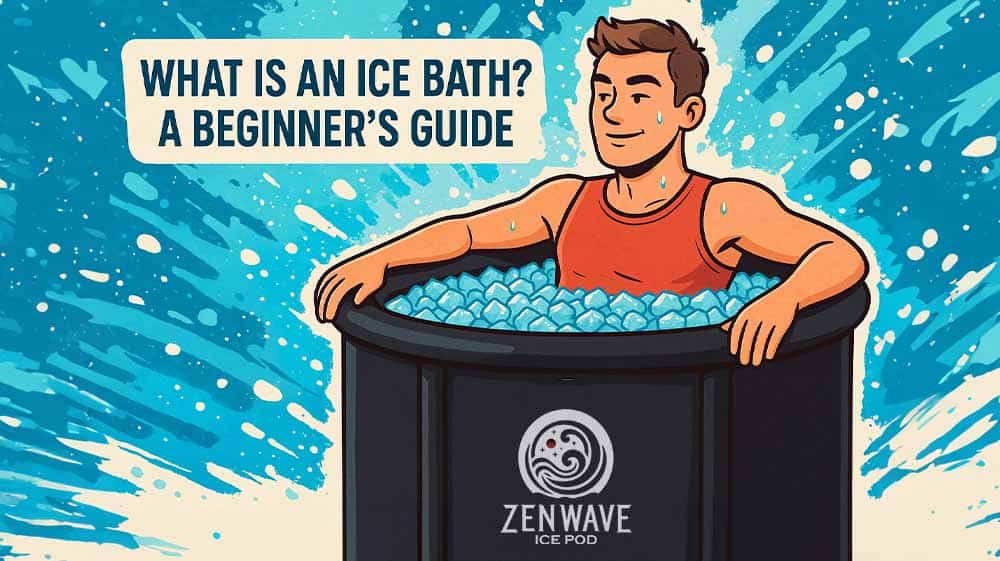If you’ve been on social media lately, you’ve likely seen athletes, wellness influencers, and even your neighbor plunging into tubs of ice water. It’s not just for show—ice baths, also known as cold plunges, have surged in popularity for their potential to boost recovery, mental resilience, and overall health. But what exactly is an ice bath? And is it right for you?
In this beginner’s guide, we’ll break down the fundamentals: what an ice bath is, how it works, and how to safely incorporate cold plunging into your routine. Whether you’re curious about how long you should stay in an ice bath, or wondering how cold an ice bath should be, this is your starting point.
What Is an Ice Bath?
An ice bath is exactly what it sounds like: a bath filled with ice and cold water, typically kept between 38°F and 50°F (3°C to 10°C). People usually immerse their bodies up to the chest for a short period of time to gain various health and performance benefits. This practice is known as cold water immersion or cold therapy.
Originally used by athletes to combat muscle soreness, ice baths have now gone mainstream for their purported benefits to mental health, immune function, and metabolic performance. Regular plunging is also associated with increased circulation and improved recovery times, making it a popular routine among high performers and biohackers.
Why Do People Take Ice Baths?
There are a few key reasons people start cold plunging:
- Muscle recovery – Reduces inflammation and DOMS (delayed onset muscle soreness) after workouts.
- Mental clarity – Helps you build mental resilience and improve focus.
- Fat loss and metabolism – Cold exposure activates brown fat, which burns calories to generate heat.
- Mood boost – Cold water stimulates the vagus nerve and boosts dopamine.
- Discipline – Doing hard things first thing in the morning sets the tone for your day.
Some users also report better sleep and fewer symptoms of anxiety and depression over time. If you want to explore these benefits more deeply, read our research-backed article benefits of ice baths.
Getting Started with Ice Baths
If you’re new to cold plunging, start slow and build up gradually. Here’s how to ease into the habit:
How Cold Should an Ice Bath Be?
For beginners, 50°F to 59°F (10°C to 15°C) is a good place to start. As your tolerance builds, you can gradually reduce the temperature to 38°F (3°C) for a more intense plunge. Anything below 50°F can trigger a strong physiological response, so start slow and track how your body reacts.
You might be wondering: Is tap water cold enough for an ice bath? Depending on where you live, it might be—especially in winter. In warmer climates or seasons, you’ll likely need added ice or a dedicated chiller.
How Long Should You Stay in an Ice Bath?
Start small. Most first-timers aim for 1–2 minutes, gradually building up to 5 or even 10 minutes. Longer isn’t always better—there’s a point of diminishing returns, and prolonged exposure can increase risk of hypothermia or frostbite.
Curious about the science? Dive into How Long Should You Stay in an Ice Bath?. Everyone’s tolerance is different, so listen to your body.
How to Take an Ice Bath at Home
You don’t need a fancy spa setup to get started. Here are three common at-home options:
- Bathtub – Easy to use, just add bags of ice to cold water. Check out our Bathtub Ice Bath Setup: A Step-by-Step Guide.
- Barrel or trash can – Inexpensive and compact, perfect for solo plungers.
- Chest freezer – With proper sealing and safety, this DIY option lets you maintain consistent cold temps.
If you’re looking for a sleek, reliable setup that’s ready out of the box, the ZenWave Ice Pod is an ideal cold plunge solution for homes, patios, and gyms.
What You Need to Get Started
Before you jump in, make sure you have:
- Thermometer (to track water temp)
- Timer (start with 1–2 minutes)
- Towel and warm clothes for after
- Optional: gloves, booties, and a friend for safety
A little preparation goes a long way toward safety and comfort. Use our First Ice Bath Checklist to make sure you’re fully prepared before your first plunge.
What to Expect During Your First Plunge
It’ll feel intense—especially in the first 30 seconds. Expect a spike in breathing and heart rate as your sympathetic nervous system kicks in. Stay calm, breathe slowly through your nose, and focus on your exhale. As your body adjusts, you may feel a shift from panic to calm—it’s a powerful moment of mental resilience. Many first-timers describe it as both a shock and a breakthrough.
What to Wear in an Ice Bath
Most wear swimsuits or athletic gear. Some add gloves or booties to protect their hands and feet, especially for longer plunges. Neoprene accessories are popular for maintaining comfort without dulling the effect. Choose form-fitting materials to avoid the distraction of loose, cold-soaked fabric. See our expert tips on what to wear for your cold plunge to stay warm where it counts.
Should You Shower Before or After?
Pre-bath showers are optional. Avoid hot water before the plunge—it can raise your core temperature and reduce the impact of the cold exposure. Afterward, warm up gradually with movement, warm clothing, or a mild shower. A brisk walk or light stretching can also help reactivate circulation. For full recovery, here’s how to warm up after cold immersion.
Best Time of Day for an Ice Bath
Mornings energize and sharpen focus. Evenings can help with relaxation, but avoid plunging too close to bedtime since cold exposure can spike alertness. Timing your plunge right can enhance sleep, workout recovery, or mental clarity depending on your goal. Find your rhythm with our guide on the best time of day for an ice bath.
How Often Should You Ice Bath?
Beginners: 1–2 times a week.
Athletes: 3–5 times post-training.
Regular exposure helps build resilience and supports recovery. Overdoing it too soon, though, can leave you drained instead of recharged. Dial in your schedule with this guide on how often to ice bath for the best results.
How Much Ice Do You Need?
For a 60-gallon tub, aim for 20–40 lbs of ice. You can use trays, blocks, or pre-bagged cubes. Consider freezing ice ahead of time in bulk to save money. For a more consistent chill, experiment with timing and water levels. Learn how to make a lot of ice for your ice baths without breaking the bank.
How to Build Cold Tolerance Over Time
Your nervous system adapts with repeated, controlled exposure to the cold. Like weight training, the key is progressive overload—adding small challenges over time to build capacity without overdoing it.
Start with water temperatures around 55–60°F (13–15°C) and limit your first sessions to 1–2 minutes. As your comfort grows, lower the temperature in 2–3°F increments and increase duration slowly, never sacrificing safety. Avoid jumping to extremes.
Consistency is more important than intensity. Aim for 2–3 short sessions per week before scaling up. Track your sessions in a journal or app—note the temperature, duration, how you felt during and after, and any physical or mental changes you notice.
Other strategies to speed up cold adaptation:
- End your showers with 30 seconds of cold water
- Practice breathwork to improve nervous system regulation
- Use contrast therapy (hot-to-cold switching) to improve vascular response
With time, your tolerance will increase. You’ll stay calm longer, shiver less, and recover faster.
Final Thoughts
Starting a cold plunge practice is easier when you have the right tools. The ZenWave Ice Pod offers a reliable, portable setup for consistent, comfortable plunges—no need to DIY your setup every time. Whether you’re just beginning or aiming to level up your protocol, the Ice Pod supports your growth with every session.
Keep showing up. Stay consistent. And let the cold work for you.

